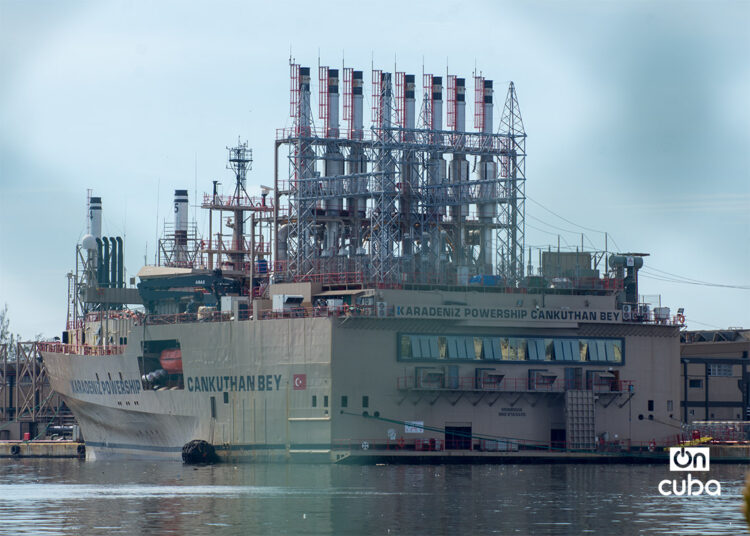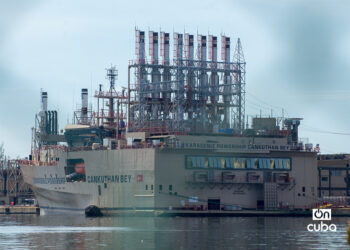A few days ago, the disconnection and subsequent departure of the largest of the Turkish floating power plants remaining in Cuba made headlines. According to the brief official information, this was due to “commercial reasons.”
The departure of the Suheyla Sultan, anchored until then in Melones Cove, Havana, resulted in the loss of 240 MW, a significant figure amid the island’s energy crisis, which has worsened in recent months.
This floating plant had arrived in Cuba more than two years earlier to complete a fleet of eight units with varying generating capacities. It did so on a leased basis, as part of an agreement between the Cuban government and the Turkish company Karadeniz Holding, which had been in place since 2019.
This equipment was installed in the bays of Havana, Mariel and Santiago de Cuba and together contributed more than 600 MW. However, the first two departed in 2023 “in accordance with the terms of the contracts,” as reported by Minister of Energ Vicente de la O Levy at the time.
Archive photo of a Turkish barge in front of the Mariel thermoelectric plant in Artemisa. Photo: Otmaro Rodríguez/Archive.
Then, in 2024, others departed until only two remained in the capital, according to what the minister himself explained during the December parliamentary sessions. On that occasion, De la O Levy attributed the departure to the “impossibility of meeting payment commitments due to the lack of foreign currency.”
To date, the amount paid by Cuba for the lease of these plants has not been made public, although independent experts — based on reports from other countries — estimate a cost in the millions. However, the island’s authorities have defended their lease as a “good deal” in the prolonged economic and energy crisis.
In 2025
After the departure of most of the floating plants, the two that remained in operation, according to various sources, were the aforementioned Suheyla Sultan, identified in official reports as the “Melones barge,” and the Erol Bay, with an approximate capacity of 63 MW and known as the “Regla barge,” due to its location in that Havana municipality.
Both had continued generating throughout 2025, albeit with increasing difficulties and shutdowns — partial or total — due to the lack of fuel, a problem that has severely impacted power generation alongside the continued breakdowns of thermal units.
Back in May, the possibility of an imminent departure of these units was denied by the Ministry of Energy and Mines (MINEN) after days of rumors on social media and media reports. These speculations had been fueled by the arrival in Havana of a cargo ship used to move large tonnages like those used by floating power plants.
Furthermore, MINEN First Deputy Minister Jesús Abad Vigoa had recently acknowledged the possibility of the removal of the barges as a “latent risk,” “given the difficulties in honoring their financial commitments,” which gave more credence to speculation that was eventually partially confirmed a few months later.
Then, in July, again before parliament, De la O Levy assured that the government had made “minimum payments to keep the barges generating during July and August,” although the Suheyla Sultan would not be long in departing.
The largest Turkish floating power plant remaining in Havana Bay was shut down for “commercial reasons.” Photo: Otmaro Rodríguez/Archive.
At the time, the minister of energy and mines stated that of the eight barges the island once had, five had been removed, bringing the number remaining in Cuba to three, although only two were regularly reported in the reports issued by the Electricity Conglomerate (UNE).
The third, apparently, was the Belgin Sultan, also known as the KPS-57, a small support barge not routinely used for generation, which suffered a fire last September, leaving two dead — both Turkish — and several injured. It reportedly remained in Havana, in the shadow of the other two.
And now?
Following the disconnection of the largest of the floating power plants, the UNE has again referred to the Regla barge, which presumably will continue generating power despite fuel problems that could paralyze its engines.
This would be, according to logical calculations, the only plant of its kind that would continue to operate regularly in Cuba.
The news is that this week, a barge in Melones has officially begun to be mentioned, even though the one that until recently was called that way is no longer on the island. In last Tuesday’s report, it was identified as KPS56, which was supposed to connect seven engines that day and provide 45 MW, although it seems that this happened last Wednesday.
So, what is this floating power plant?
Well, it’s the Cankuthan Bey, as our photojournalist Otmaro Rodríguez confirmed on-site. It is anchored there next to the aforementioned Belgin Sultan.
The Turkish barge Belgin Sultan in Melones Cove, Havana, on Wednesday, August 13, 2025. Photo: Otmaro Rodríguez.
The Turkish barge Cankuthan Bey in Melones Cove, Havana, on Wednesday, August 13, 2025. Photo: Otmaro Rodríguez.
This is a barge that arrived in December after the departure of other plants, generating rumors and expectations. However, UNE assured at the time that it was only passing through Havana waters, where “start-up work on its units” would be carried out, and once this work was completed, it would leave the island. It is unclear whether it ultimately did so.
According to available information, the Cankuthan Bey has a capacity of 80 MW, a third of what the Suheyla Sultan could generate, although higher than that of the Regla barge. If it provides full capacity, which would also depend on fuel availability, it would partially fill the gap left by the recently shut-down plant.
So far, Cuban authorities have not provided public details about its start-up or how long it would remain in operation. Nor have they provided any in-depth explanations of what happened to the Suheyla Sultan, beyond stating that its shutdown was due to “commercial reasons.”
With it, there would once again be two floating plants operating in Havana, and three if we include the Belgin Sultan, whose nominal capacity would be much lower. If nothing is officially clarified in this regard, the coming weeks and — hopefully — months will reveal its potential contribution and significance amid Cuba’s p
recarious energy situation.







